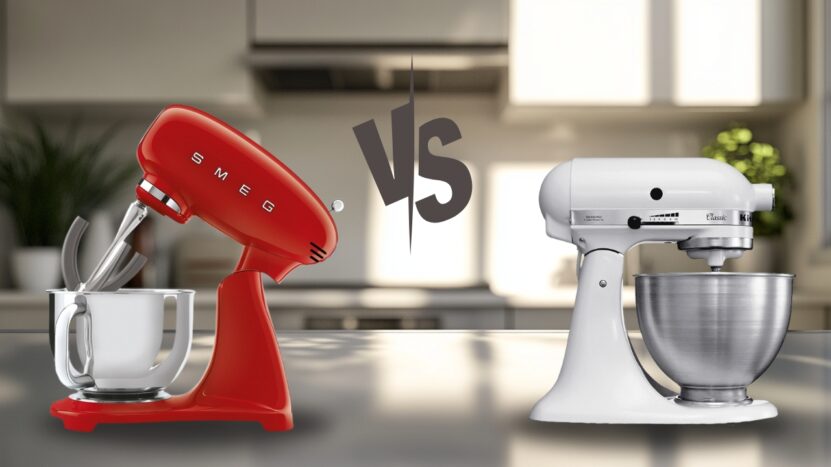
Share Post:
When it comes to stand mixers, two brands often dominate the conversation:
- KitchenAid
- Smeg
Both with long-standing reputations and strong product lines, these brands are known for their quality, durability, and distinctive design.
But which one truly stands out as the best?
In this post, we’ll take a closer look and compare KitchenAid and Smeg head-to-head in a showdown of stand mixers.
The Contenders
Before we go into nitty-gritty comparisons, let’s get to know our contenders.
KitchenAid
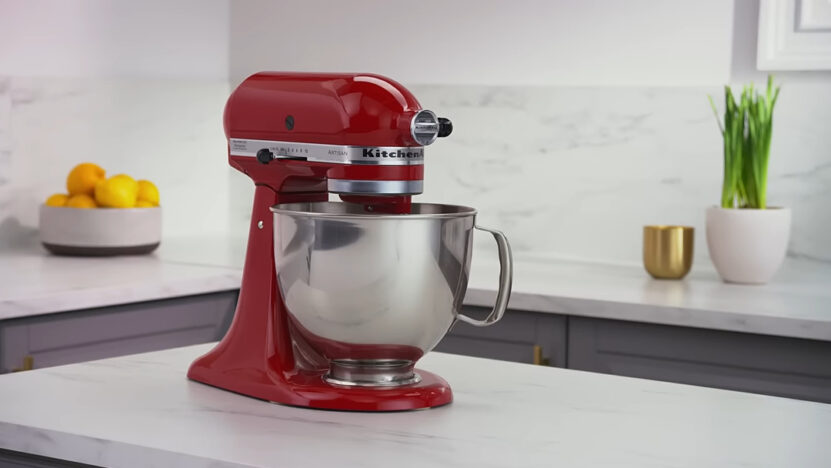
Founded in 1919, KitchenAid has been a staple in American kitchens for over a century.
Known for its high-quality craftsmanship, KitchenAid has set the standard for stand mixers and other kitchen appliances, offering a perfect blend of durability and performance.
Over the years, KitchenAid has evolved its product range while maintaining the reliability that has made it a household name.
- Classic Series Stand Mixer: Known for its simplicity and reliability.
- Artisan Series Stand Mixer: Features a more powerful motor and a wide range of colors, making it a favorite for home bakers.
Notable Features:
- 10-speed settings for versatility.
- Durable, all-metal construction.
- Attachments for tasks like pasta-making, grinding, and juicing.
Why Choose KitchenAid:
- Trusted for its durability and long-standing performance.
- A broad variety of attachments for multifunctional use.
- A timeless design that fits both modern and traditional kitchens.
Smeg
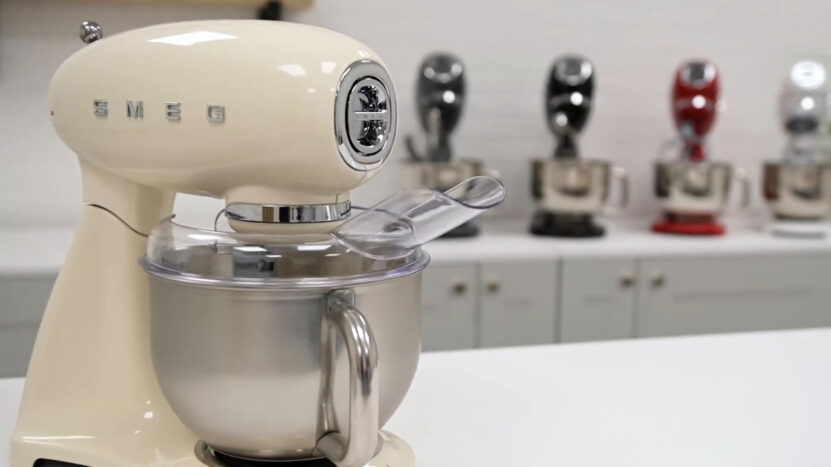
Smeg, an Italian company established in 1948, is renowned for its stylish, retro-inspired appliances that combine cutting-edge technology with chic, nostalgic designs.
Smeg has earned a reputation for appealing to design-conscious consumers who want both form and function in their kitchen.
- Smeg 50’s Retro Style Aesthetic Stand Mixer: Known for its eye-catching, mid-century design and solid performance.
Notable Features:
- Available in a range of pastel colors and sleek finishes.
- Die-cast aluminum body for a sturdy feel.
- Smooth, planetary mixing action for even results.
Why Choose Smeg:
- Ideal for those who prioritize aesthetics and design in their kitchen.
- Blends retro charm with modern functionality.
- Offers premium quality while making a bold style statement.
Both KitchenAid and Smeg offer premium stand mixers, but their distinct styles and features cater to different types of users.
KitchenAid emphasizes reliability and versatility, while Smeg attracts those looking for high performance with a flair for design.
Power & Precision
When it comes to selecting a stand mixer, two key factors often top the list for home bakers:
- Power
- Precision
A powerful motor can handle heavier doughs and longer mixing times without strain, while precision ensures that ingredients are thoroughly combined for perfect results every time.
Now, we’ll compare the performance of KitchenAid and Smeg stand mixers, evaluating both power and how effectively each brand’s mixer handles various kitchen tasks.
KitchenAid
KitchenAid’s Artisan Series mixer features a reliable 325-watt motor, while the Classic Series comes with a slightly less powerful 250-watt motor.
Despite not being the most powerful on the market, KitchenAid mixers are well-regarded for their consistent performance and efficiency.
The key to their success lies in the planetary mixing action, a feature that ensures the attachment moves in multiple directions as it rotates, thoroughly mixing all ingredients without leaving any untouched spots in the bowl.
It reduces the need for frequent scraping, making the mixing process smoother and more efficient.
- Artisan Series: 325 watts
- Classic Series: 250 watts
Mixing Action:
- Planetary mixing motion for thorough, even results
Performance Highlights:
- Ideal for general mixing tasks, including batter, dough, and whipping.
- Handles most home-baking recipes with ease.
- Well-balanced performance for light to medium-duty mixing.
Smeg
Smeg’s stand mixer, on the other hand, offers a significant power upgrade with its 600-watt motor, nearly double the strength of KitchenAid’s Artisan Series.
This extra power gives Smeg a noticeable advantage, particularly when tackling more demanding tasks such as kneading thick doughs or mixing for extended periods. Like KitchenAid, Smeg also employs planetary mixing action, ensuring a thorough blend of ingredients.
The additional motor strength ensures it maintains steady performance, even under heavy loads, making it an excellent option for bakers who frequently work with tougher mixtures like bread dough or dense cake batters. Therefore, it is a great choice if you don’t have a blender inside your kitchen.
- Smeg Stand Mixer: 600 watts
Mixing Action:
- Planetary motion for uniform and efficient mixing
Performance Highlights:
- Excels with heavier doughs and extended mixing sessions.
- High-powered motor provides greater versatility for more complex recipes.
- Offers smooth performance even with larger batches or challenging textures.
If raw power is the primary consideration for your kitchen tasks, Smeg’s 600-watt motor stands out as the clear winner, especially for those who frequently bake with heavy doughs or require prolonged mixing times.
However, despite its lower wattage, KitchenAid’s mixers offer remarkable precision and consistency for most home baking needs. For general, everyday mixing, both brands perform exceptionally well, but the Smeg mixer’s added power gives it an edge for more demanding recipes.
Capacity
When considering a stand mixer, bowl capacity plays a crucial role, especially for those who frequently bake in large quantities. Here’s how KitchenAid and Smeg stack up in this department:
KitchenAid
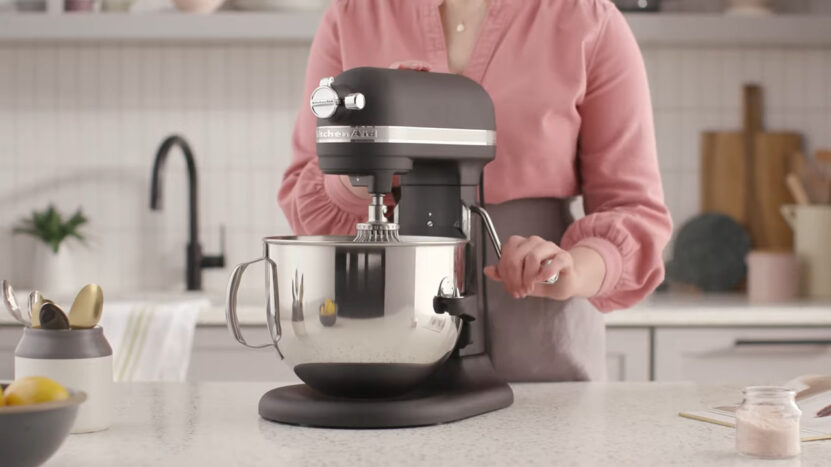
Equipped with a generous 5-quart stainless steel bowl, the model is large enough to handle substantial baking tasks.
You can mix dough for up to nine dozen cookies or knead enough dough for four loaves of bread in one batch, making it ideal for those who bake in bulk.
Slightly smaller with a 4.5-quart bowl, this model is still more than capable of handling the demands of the average home baker. It’s great for whipping up cakes, bread, or everyday desserts without feeling too bulky.
Smeg
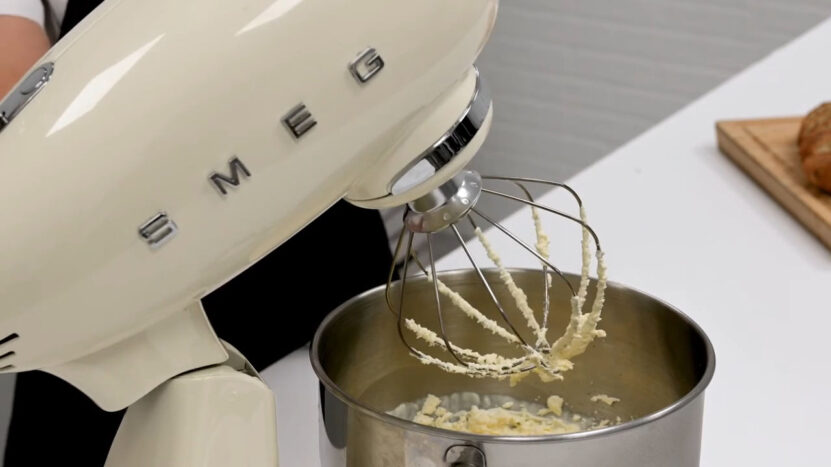
Featuring a 4.8-quart stainless steel bowl, Smeg’s mixer offers a capacity almost identical to KitchenAid’s.
While it’s slightly smaller than the Artisan Series, the difference is minimal, and the 4.8-quart size should easily meet the needs of most home cooks and bakers.
KitchenAid wins by a small margin, thanks to the slightly larger bowl of the Artisan Series.
However, both KitchenAid and Smeg provide ample space for everyday baking tasks, so capacity should not be a deal-breaker for most.
Design & Aesthetics
Stand mixers are not just functional kitchen appliances; they also serve as statement pieces in many kitchens. The design and aesthetics of a mixer can play a significant role in the decision-making process, and this is where KitchenAid and Smeg truly differ.
KitchenAid
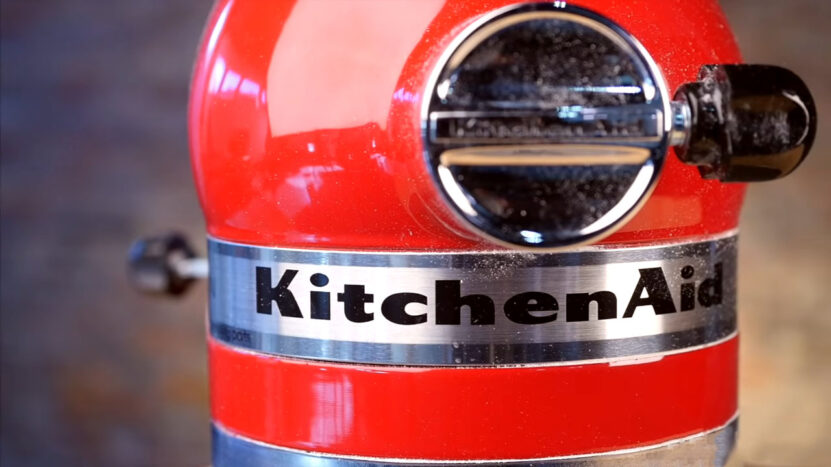
Known for its classic and timeless design, KitchenAid mixers draw inspiration from their original 1937 model. The mixers have clean lines and are available in a wide array of colors, ranging from bold to neutral tones, making them a versatile addition to any kitchen decor.
The heavy-duty, all-metal construction ensures that KitchenAid mixers are built to last. Whether you prefer a modern kitchen look or something more traditional, KitchenAid offers a design that’s both elegant and durable, blending seamlessly into a wide variety of styles.
Smeg
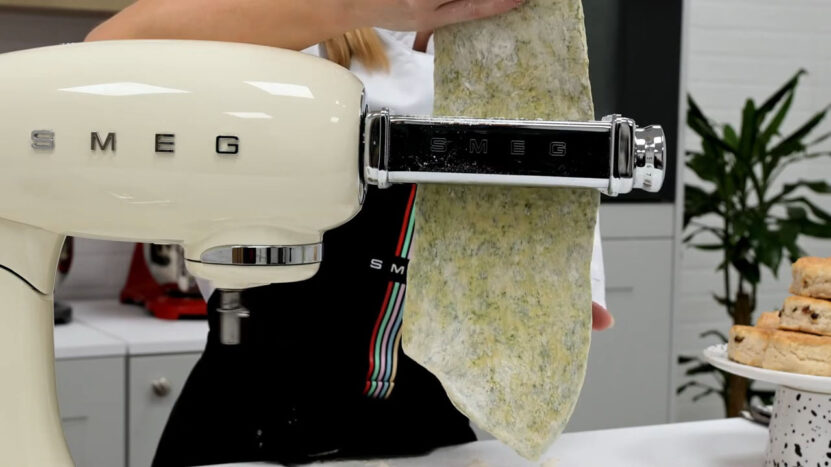
Smeg mixers are designed to stand out. With their distinctive 50’s retro aesthetic, Smeg appliances bring a splash of nostalgia and character to any kitchen. Rounded edges, a glossy finish, and vibrant color options make these mixers eye-catching, perfect for those who want to make a bold design statement.
Like KitchenAid, Smeg mixers are also made with high-quality metal construction, ensuring durability while delivering style.
The choice between KitchenAid and Smeg in this category is purely subjective. If you’re after a timeless, versatile design that fits with almost any decor, KitchenAid is your go-to. On the other hand, if you want to add a retro flair with eye-catching colors and a unique, vintage vibe, Smeg is the clear winner. Both offer premium quality, but it ultimately comes down to your aesthetic preferences.
Extra Features & Ease of Use
When choosing a stand mixer, it’s not just about power and design—extra features and ease of use can greatly enhance your overall baking experience.
Both KitchenAid and Smeg offer user-friendly designs and helpful features, but each brand has its approach to simplifying your time in the kitchen. Let’s explore what they bring to the table.
KitchenAid
KitchenAid’s signature tilt-head design allows you to easily access the bowl, making it simple to add ingredients or swap out attachments without hassle.
The design also comes with a locking mechanism to ensure stability during mixing, preventing any unwanted movement while in use.
With a side-mounted control lever, KitchenAid mixers are intuitive to use. The lever adjusts through ten distinct speed settings, offering precise control whether you’re whipping cream or kneading dense bread dough.
The speed range allows for delicate tasks as well as heavy-duty mixing, giving you flexibility for various recipes.
- Dough Hook: Ideal for kneading dough.
- Flat Beater: Perfect for mixing batters and mashed potatoes.
- Wire Whip: Designed for whipping cream, egg whites, and more.
These three attachments make the mixer versatile enough to handle a wide range of tasks right out of the box, from kneading bread dough to whipping meringues.
While KitchenAid’s standard attachments are sufficient for most tasks, additional accessories like a pouring shield or scraper beater need to be purchased separately.
Smeg
Tilt-Head with Safety Lock: Like KitchenAid, Smeg’s stand mixer features a tilt-head design that locks securely into place, making it easy to access the mixing bowl and change attachments. The head’s locking feature ensures safety and stability during use.
Smeg mixers feature an ergonomically placed control knob, allowing you to smoothly adjust between ten variable speeds. This ensures precise control over the mixing process, whether you’re slowly folding ingredients or whisking at high speed.
The easy-to-reach controls are designed with comfort in mind, allowing you to adjust speeds seamlessly while multitasking in the kitchen.
- Wire Whisk: For whipping and aerating.
- Flat Beater: For general mixing tasks.
- Dough Hook: For kneading and bread-making.
- Spatula: Handy for scraping the sides of the bowl or folding ingredients.
- Pouring Shield: To prevent splattering while mixing, especially useful for wet or powdery ingredients.
These extra tools help reduce mess and add convenience, allowing you to achieve professional-level results straight out of the box without needing to purchase additional accessories.
Both KitchenAid and Smeg offer user-friendly designs that make them easy and enjoyable to operate. KitchenAid wins points for its reliability and the wide range of speed settings, attachments, and optional add-ons that expand its versatility.
However, Smeg has a slight advantage with its extra accessories like the spatula and pouring shield included in the standard package, adding a touch of convenience and reducing the need for separate purchases.
If you value having a complete set of tools right from the start, Smeg’s additional features might just win you over.
The Verdict
Deciding between KitchenAid and Smeg comes down to your personal priorities in a stand mixer. If you’re after a powerful machine with standout retro aesthetics and are willing to invest a bit more, Smeg offers an excellent blend of performance and style.
However, if versatility, durability, and a wider range of attachment options at a better price point are what you seek, KitchenAid is the more practical choice.
Ultimately, both KitchenAid and Smeg produce high-quality stand mixers that will serve any home baker well.








